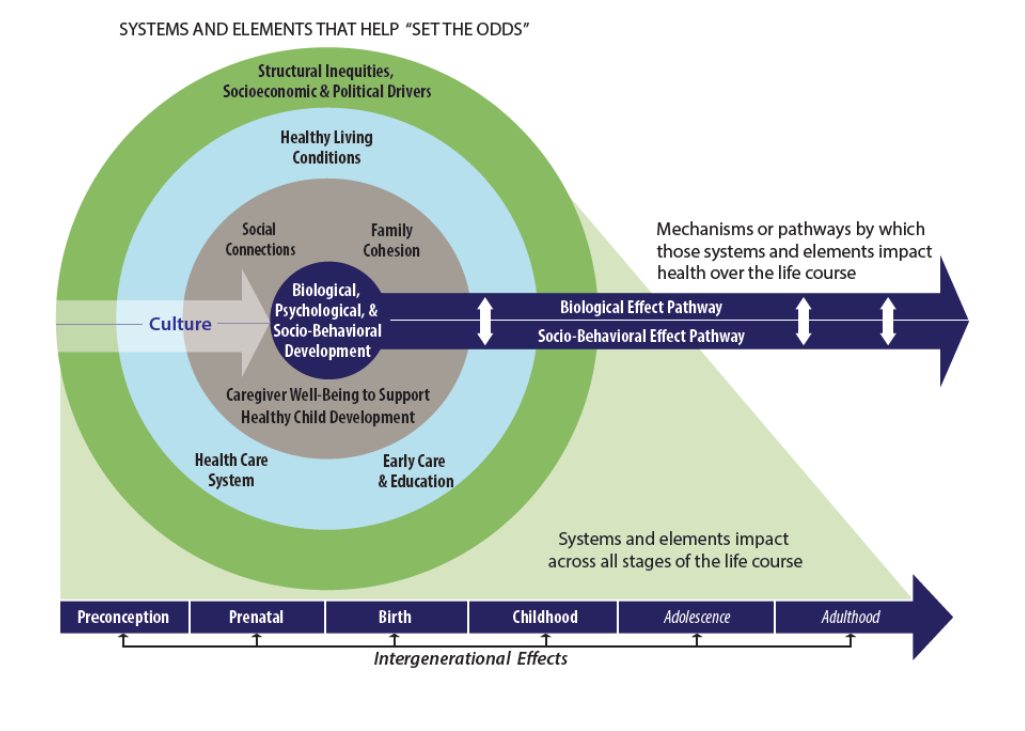
Share On Social!
Early experiences can influence a person’s entire life.
Specifically, stress due to adversity, poor nutrition, and exposure to environmental toxins can lead to biological changes, which make people more likely to experience physical and mental health problems later in life.
Although individual interventions are important for addressing immediate needs, they alone will not advance health equity, according to a new report from the National Academies of Sciences, Engineering, and Medicine.
The report provides science-driven recommendations to address the social, economic, environmental, and cultural determinants of health and early adversity.
They say to advance health equity, decision-makers must address the systemic root causes of poor health and chronic adversity.
 “Practice, policy, and systems-level changes informed by science can reduce the odds of adverse exposures, narrow health disparities, and advance health equity,” the report states.
“Practice, policy, and systems-level changes informed by science can reduce the odds of adverse exposures, narrow health disparities, and advance health equity,” the report states.
Root Causes of Poor Health
“Research shows that exposure to factors that shape health trajectories can start early and are multi-generational; thus, [early life] periods are critical to setting the odds for lifelong health,” the report states.
Disparities in health trajectories are a function of poor conditions, not poor people.

Structural inequities are a significant root cause of health disparities.
Deeply embedded in policies and culture, they distribute power and resources by race and social class, creating healthy living conditions for some and unhealthy living conditions for others.
Conditions include:
- Quality of early care and education
- Employment opportunities
- Affordability and quality of housing
- Safety and reliability of transportation networks
- Access to healthy food
- Economic mobility and ability to accrue wealth
- Public safety
- Access to and quality of health systems and services
- Safety and inclusiveness of physical and social environments
- Presence of environmental toxins
Systematic Education and Health Inequities in Place
The institutions meant to serve all Americans equally are actually contributing to the hardships Latinos and other minorities face today.
Funding inequities between rich and poor schools, for example, contribute to gaps in achievement and disparities in health.
“The United States spends approximately 7%—or $1,000—less per pupil on students in the highest poverty districts than those educated in the wealthiest,” the report states.
The health care system cannot cure unhealthy living conditions like funding inequities between rich and poor schools.
“Despite high-quality clinical care, the health status of America’s children and young families is far worse than in comparable developed countries,” the report states.
The current health care system focuses mainly on clinical goals and often delivers fragmented services ignoring mental and behavioral health, disparities, adversity, family well-being, and living conditions.
“Addressing the fundamental needs of families and children (i.e., economic stability, food security, and a safe and healthy living environment) is critical to achieving health and well-being during the prenatal through early childhood periods,” the report states.

“The single most important factor in promoting positive psychosocial, emotional, and behavioral well-being in children is having safe, stable, and nurturing relationships with their mother, father, or other primary caregiver.”
Recommendations and Resources
The report provides 29 recommendations across the following eight key strategies:
- Intervene early: In most cases, early intervention programs are easier to implement, more effective, and less costly.
- Support caregivers: This includes both primary caregivers and caregivers in systems who frequently interact with children and their families.
- Reform health care system services to promote healthy development: Redesign the content of preconception, prenatal, postpartum, and pediatric care while assuring ongoing access, quality, and coordination.
- Create supportive and stable early living conditions: reduce child poverty and address economic and food security; provide stable and safe housing; and eliminate exposure to environmental toxins.
- Maximize the potential of early care and education to promote health outcomes.
- Implement initiatives across systems to support children, families, other caregivers, and communities: Ensure trauma-informed systems, build a diverse and supported workforce, and align strategies that work across sectors.
- Integrate and coordinate resources across the education, social services, criminal justice, and health care systems, and make them available to translate science to action.
Careful attention for subgroups of children known to be vulnerable, such as those living in chronic poverty, children from immigrant backgrounds, children in foster care, and children with incarcerated parents should be considered.
The report also provides a roadmap to apply the science of early development through specific actions and actors, as well as a social media toolkit to promote the report.
Share this report with colleagues and local and state decision makers.
By The Numbers
28
percent
of Latino kids suffer four or more adverse childhood experiences (ACES).



